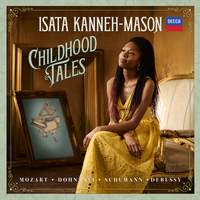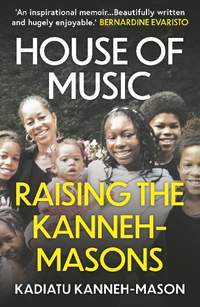Interview,
Isata Kanneh-Mason's Childhood Tales

In the run-up to her performances of the Dohnányi in Detroit this week, Isata spoke to me about growing up in a 'house full of music', her passion for working with the next generation of young musicians, and how each piece featured on the album came into her life...
What are you own earliest musical memories?
I have a very blurred recollection of having some recorder lessons when I was about three, but I can’t remember anything at all about the music itself! My first piano memory is from when I was about five; we were on holiday at my grandparents’ house in the Caribbean, and they had an upright piano which I was really drawn to. I remember sitting down and trying to play the Rugrats theme-tune, and my auntie came out and said it sounded like angels - at that age you’re so impressionable that I genuinely believed her!
I’m not 100% sure that this was my very first public performance, but when I was about eight I entered the Nottinghamshire Music Festival (in what sadly turned out to be its final year), playing a piece called ‘Knecht Ruprecht’ from Schumann’s Album für das Jugend. It was around then that I asked my mum if being a pianist was something you could do for a job, and she said ‘Absolutely!’. That was when I started taking it seriously, and I asked if I could study at a proper music-school; the wonderful Patsy Toh taught me at the Academy’s Junior Department from the age of 10 to 18, and she was a massive inspiration in all sorts of ways. I also grew up on recordings of Vladimir Ashkenazy and Martha Argerich, and was convinced I was going to be exactly like them one day...
Nottingham was fantastic for live classical music when I was growing up, and fortunately it’s much the same today: the Royal Concert Hall is still standing, and it’s always had a great programme of visiting artists. My brother saw his heroes including Steven Isserlis, Nicola Benedetti and Joshua Bell, and I remember seeing the great Stephen Hough there and being so inspired by his playing. But one of the things that stuck most in my memory was actually opera: my parents took me to see La traviata when I was very young, and that combination of music and drama had such a profound effect on me.
And how long was it before your younger siblings started following in your footsteps?
My brothers started instrumental lessons fairly soon after I did, so I don’t really have many memories of being the only person playing in our house: my childhood was all about everyone making music together! I remember practising against a backdrop of everyone else practising, playing chamber music with my brothers and accompanying one other, making arrangements together and listening to CDs…music was always present in some shape or form. Arranging pieces was something that always came very naturally to us from a young age, and we still keep that going whenever time permits.
With such a busy performance-schedule, are you able to carve out much time to pass the baton onto the next generation of aspiring young musicians?
Yes, definitely! At the moment I’m doing an education project called RPO Resound with the Royal Philharmonic Orchestra, going into primary and secondary schools in London and working with the children there. I also just got back from Antigua, where for the last five years or so my family have been involved with a project to create a youth orchestra [the Antigua and Barbuda Youth Symphony Orchestra]. It’s very much up and running now, and we go back out there every year to support them and do concerts.

Turning to the works on your new album, when did Dohnányi's Variations on a Nursery Tune come onto your radar?
I was about twenty and studying for my undergraduate degree at the Royal Academy of Music, and I went to listen to one of the postgraduate students playing it with the Academy orchestra. I didn’t know anything about the piece, not even its title - I just assumed it was a Dohnányi concerto. All the way through that dramatic orchestral introduction I was wondering how the piano would enter…and when it finally did enter [with the ‘Twinkle, Twinkle, Little Star’ theme] the entire audience just burst out laughing! I completely fell in love with the piece and just had to play it myself – though I quickly discovered that once you’ve got past the opening theme things do get a lot more difficult…
Recording it with the Royal Liverpool Philharmonic Orchestra was a joy, because Domingo [Hindoyan, their Chief Conductor] is such a wonderful musician. He’s just great to work with, because he strikes the perfect balance between authority and collaboration: he has such command of the orchestra and the music, but was also so open to listening to me and taking my ideas about the piece on board.
Had all of the solo works on the album been with you since childhood?
I learned the Mozart variations when I was twelve, and just last week we dug out an old recording of me playing them back then! It’s been nice to come back to the piece, because once you’re a bit older you come to appreciate just how many inventive, intricate things he does with that most familiar of tunes. There are some variations where the tune is buried deep within the harmony underneath flurries of semiquavers, then he puts it into a minor key, plays with tempi, transfers the tune to the left hand with arpeggios in the right…I used to feel like he did everything possible with that tune, then I discovered that Dohnányi had taken it even further! But it’s fair to say that Mozart explored everything that was possible within his own musical language – that he could get so much mileage out of such simple material still blows my mind.
I’ve known Debussy’s Children’s Corner for years, but Schumann’s Kinderszenen is something I discovered much later in life: with the exception of ‘Träumerei’ (which is a piece I grew up with), I only learnt it about a year ago. The opening of the piece gets me every time, because I just think the harmony in those first four bars is so beautiful. That first movement was used in Greta Gerwig’s 2019 film of Little Women in a way that I found really moving, and I also heard a lovely story about Liszt discovering the piece and sending Schumann a message saying he just played those first four bars on loop for hours. That response exactly encapsulates what I feel about it.
Isata Kanneh-Mason (piano), Royal Liverpool Philharmonic Orchestra, Domingo Hindoyan
Available Formats: CD, MP3, FLAC, Hi-Res FLAC
Kadiatu Kanneh-Mason
Available Format: Book




